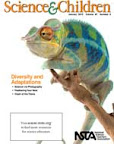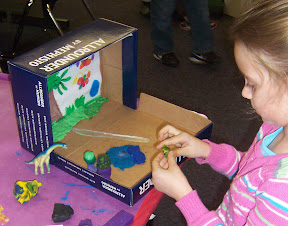If you were a dinosaur …
By Peggy Ashbrook
Posted on 2009-12-31
Some children love pandas, some love dogs, but many more love dinosaurs. At times it seems young children feel dinosaurs are “more real”—more interesting, more important, more present in their minds—than modern animals. “More real” might be an exaggeration, but details about dinosaurs are verbalized more often than those about most modern animals. They can tell you that “ a Troodon has three toes and one extra long sharp claw” and “a T.Rex has really big sharp teeth” but have difficulty describing the length or number of teeth or toes of a dog. (Just my perception, and not a result from any kind of survey, or maybe it’s my own prejudice, reflecting my interest in fossils.)
You can use this intense interest in dinosaurs to teach about how animal body shapes help animals survive in their environment. To get children to think about and research how dinosaurs lived, ask the children, “If you were a dinosaur, what kind of dinosaur would you be?” Open-ended questions about their dinosaur will encourage them to search and talk about details—“What shape were its feet? I wonder what its ears looked like, or why were its eyes on the sides of its head?”
 Use the resources listed in this post and in the January 2010 Early Years column in Science and Children. Teachers and older students can use The Dino Database to learn how to pronounce dinosaur names and how they are grouped. Design activities or assignments that draw attention to details such as type of teeth, shape of feet, and fossil evidence for behavior such as living in herds or nest building. This directs their thinking to how the shape of the dinosaur and fossil evidence gives clues to how they may have lived.
Use the resources listed in this post and in the January 2010 Early Years column in Science and Children. Teachers and older students can use The Dino Database to learn how to pronounce dinosaur names and how they are grouped. Design activities or assignments that draw attention to details such as type of teeth, shape of feet, and fossil evidence for behavior such as living in herds or nest building. This directs their thinking to how the shape of the dinosaur and fossil evidence gives clues to how they may have lived.
Children reveal their understanding in their imaginative play. Do they have the toy Maiasauras construct nests and care for the babies, and have the carnivorous Coelophysis (also called “Rioarribasaurus”) eat only animals, and when pretending to be Diplodocus on the playground do they run in herds?
While learning about dinosaurs students can learn about the nature of science—how, with further study and new technology, new discoveries are made changing what we know about dinosaurs.
Here are some resources that will be of interest to you and your students.
Books about dinosaurs, nonfiction and fiction
- Dinosaurs, Amazing Dinosaurs: The Fiercest, the Tallest, the Toughest, the Smallest, and Amazing Dinosaurs: More Feathers, More Claws, Big Horns, Wide Jaws! all by Dougal Dixon (1998, 2000, and 2007, Boyds Mills Press). Details are easy to see in the large drawings about the variety in dinosaur bodies.
- First Dinosaur Encyclopedia by DK Publishing (2006, DK Children). With a timeline and fascinating details about specific dinosaurs, this book will help teachers and children alike make sense of the ever-expanding list of known dinosaur species—when and how they lived.
- How Do Dinosaurs Say Goodnight? and How Do Dinosaurs Say I Love You? series by Jane Yolen, illustrated by Mark Teague (2000, 2009, Blue Sky Press). No one is better than Jane Yolen at imaginative story telling, and children love to see themselves represented as the dinosaurs they imagine themselves to be. See if your class can identify dinosaurs such as the Kentrosaurus or Pachycephalosaurus outside of their usual habitat, and tell you what their bodies were able to do.
Resources about scientific work
- Watch “Uncovering Tawa hallae”, a 5 minute National Science Foundation audio slideshow about the discovery and analysis of the fossil of a Triassic, carnivorous dinosaur. Scroll down and click on “downloads” to print out cool photos of the fossil, the reconstructed skeleton, the Ghost Ranch fossil bed, and the paleontologist team.
- In Science News for Kids (11/19/09), paleontologist Jack Horner tells how fossils representing what were thought to be 3 kinds of dinosaurs were revealed by CAT scans to (probably) be only one kind, but at 3 different stages of growth, juvenile, teenager, and adult.
- When I was growing up, dinosaurs were thought to be slow moving animals that dragged their tails. The books we owned were, Dinosaurs (A Little Golden Book) by Jane Werner Watson, illustrated by William de J. Rutherfoord (Golden Press;1959), and a work of fiction, Danny and the Dinosaur (An I Can Read Book, Level 1) by Syd Hoff (1958, HarperCollins). Since then scientists have researched how animals balance and the type of stride that would make the fossilized footprints that have been uncovered—without an accompanying tail print—and determined that dinosaurs probably lifted their tails as they moved.
- Teachers can see lists of works with early illustrations of dinosaurs on these sites to use when searching for illustrations that represent out-dated ideas:
- What’s Wrong With This Picture? An Audio Critique: Listen to dinosaur paleontologist Thomas Holtz talk about tail dragging versus raised tails and other revisions on National Geographic. com
Activities to assess children’s knowledge about how dinosaurs related to their habitat
Build a diorama
Construct a
diorama based on research—picture research or text reading. Provide shoeboxes, small, accurate models of dinosaurs, plasticine clay to anchor the dinosaurs and paper to draw pictures of the appropriate habitat including food source. (Hint: trioramas can be made with a single sheet of paper if you do not have easy access to shoeboxes. See www.reallygoodstuff.com/pdfs/144012.pdf and www.mcsdk12.org/curr/WebQuests/Spider/Triorama.htm for directions.)
Write a poem
Write a poem about a physical characteristic of the chosen dinosaur explaining how the body part functioned to help the dinosaur species survive. Your students might be inspired by Jack Prelutsky’s Tyrannosaurus Was a Beast (illustrated by Arnold Lobel). Some language may be above most young children but those who love language will enjoy the challenging words such as “slaughtered”, “nibbled”, “perpetual”, and “morsel.”
Play a game
Play “I’m thinking of a dinosaur body feature that is for…” and have students call out names of dinosaur body features which fit the named category (eating plants, catching animals, keeping warm, running fast, balancing a big head, eating meat, hiding among plants, climbing, or other description that allows for many answers). For example, “I’m thinking of a dinosaur body feature that would help a dinosaur see well to hunt.” Possible correct answers: big eyes, eyes facing forward, good eyesight. Students could be asked to explain their answer and give an example of a dinosaur that shows that body shape.
Have a good time using dinosaurs as the topic for learning about how animal bodies are shaped to perform a particular function,
Peggy
Disclaimer: The views expressed in this blog post are those of the author(s) and do not necessarily reflect the official position of the National Science Teaching Association (NSTA).



